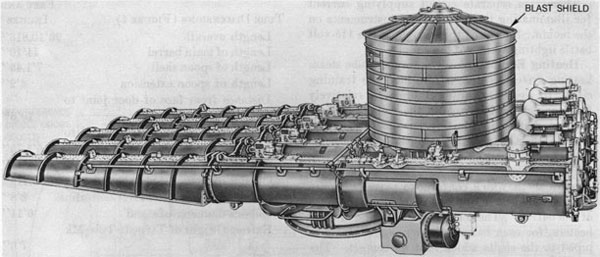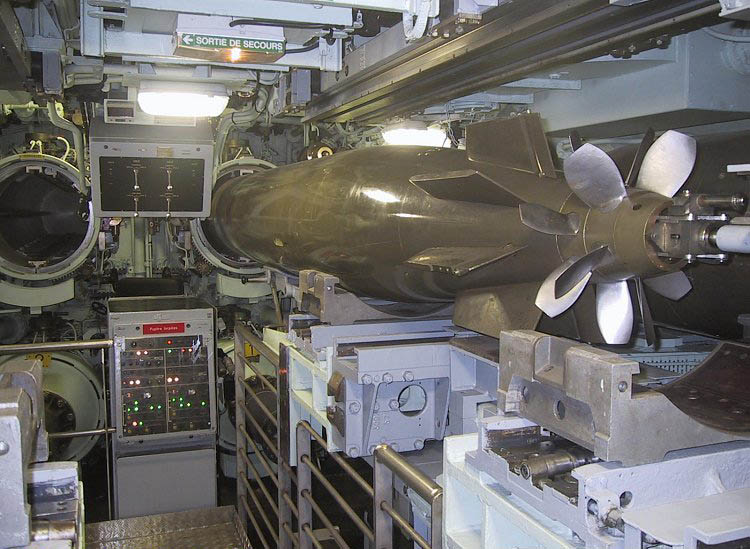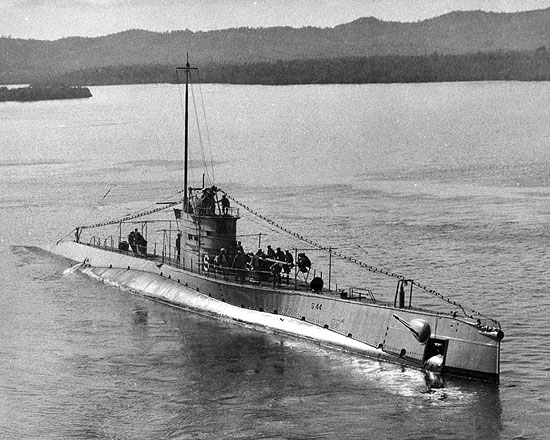|
Mark 14 Torpedo
The Mark 14 torpedo was the United States Navy's standard submarine-launched anti-ship torpedo of World War II. This weapon was plagued with many problems which crippled its performance early in the war. It was supplemented by the Mark 18 electric torpedo in the last two years of the war. From December 1941 to November 1943 the Mark 14 and the destroyer-launched Mark 15 torpedo had numerous technical problems that took almost two years to fix. After the fixes, the Mark 14 played a major role in the devastating blow U.S. Navy submarines dealt to the Japanese naval and merchant marine forces during the Pacific War. By the end of World War II, the Mark 14 torpedo was a reliable weapon ultimately remaining in service for almost 40 years in the U.S. Navy, and even longer with other navies. Development The design of the Mark 14 started in January 1931; the Navy allocated $143,000 for its development. The Mark 14 was to serve in the new "fleet" submari ... [...More Info...] [...Related Items...] OR: [Wikipedia] [Google] [Baidu] |
Anti-surface Warfare
Anti-surface warfare (ASuW or ASUW) is the branch of naval warfare concerned with the suppression of surface combatants. More generally, it is any weapons, sensors, or operations intended to attack or limit the effectiveness of an adversary's surface ships. Before the adoption of the submarine and naval aviation, all naval warfare consisted of anti-surface warfare. The distinct concept of an anti-surface warfare capability emerged after World War II, and literature on the subject as a distinct discipline is inherently dominated by the dynamics of the Cold War. Categories of anti-surface warfare Anti-surface warfare can be divided into four categories based on the platform from which weapons are launched: * Air (or aviation): Anti-surface warfare conducted by aircraft. Historically, this was conducted primarily through level- or dive-bombing, strafing runs or air-launching torpedoes (and in some cases by suicide attacks). Today, air ASuW is generally conducted by stand-off ... [...More Info...] [...Related Items...] OR: [Wikipedia] [Google] [Baidu] |
Mark 15 Torpedo
The Mark 15 torpedo was the standard American destroyer-launched torpedo of World War II. It was very similar in design to the Mark 14 torpedo except that it was longer, heavier, and had greater range and a larger warhead. The Mark 15 was developed by the Naval Torpedo Station Newport, Rhode Island, Newport concurrently with the Mark 14 and was first deployed in 1938. It served as a replacement for the Mark 8 torpedo, Mark 11 torpedo, Mark 11 Torpedo and Mark 12 torpedo, Mark 12 Torpedo on surface ships with tubes that could accommodate the longer Mark 15; this primarily included destroyers built after 1930. Older destroyers, primarily the Wickes-class destroyer, ''Wickes'' and Clemson-class destroyer, ''Clemson'' classes, continued to use the Mark 8, as did PT boats early in World War II. During the war 9,700 were produced at Newport and at the Naval Ordnance Station Forest Park, Illinois. The Mark 15 had the same Mark 14 torpedo#Problems, basic design problems that plagued the ... [...More Info...] [...Related Items...] OR: [Wikipedia] [Google] [Baidu] |
Magnetic Influence
Magnetic pistol is the term for the device on a torpedo or naval mine that detects its target by its magnetic field, and triggers the fuse for detonation. A device to detonate a torpedo or mine on ''contact'' with a ship or submarine is known as a contact pistol. A magnetic pistol on a mine will allow the mine to detonate in proximity to a target, rather than actual contact, allowing the mine to cover a larger effective area. A magnetic pistol on a torpedo allows the torpedo to detonate underneath the ship, instead of upon impact with the side of the ship. As an explosion underneath a ship is contained between water and the ship, far more damage will result to the ship. The explosion will lift the ship out of the water and may break the keel of the ship, splitting it in two. Any hole created by the explosion will be on the bottom, causing more flooding. A contact pistol on a torpedo will require the torpedo to strike the side of the ship. Any hole created by the explosion will ... [...More Info...] [...Related Items...] OR: [Wikipedia] [Google] [Baidu] |
Keel
The keel is the bottom-most longitudinal structural element of a watercraft, important for stability. On some sailboats, it may have a fluid dynamics, hydrodynamic and counterbalancing purpose as well. The keel laying, laying of the keel is often the initial step in constructing a ship. In the British and American shipbuilding traditions, this event marks the beginning date of a ship's construction. Etymology The word "keel" comes from Old English language, Old English , Old Norse , = "ship" or "keel". It has the distinction of being regarded by some scholars as the first word in the English language recorded in writing, having been recorded by Gildas in his 6th century Latin work ''De Excidio et Conquestu Britanniae'', under the spelling ''cyulae'' (he was referring to the three ships that the Saxons first arrived in). is the Latin word for "keel" and is the origin of the term careening, careen (to clean a keel and the hull in general, often by rolling the ship on its side). An ... [...More Info...] [...Related Items...] OR: [Wikipedia] [Google] [Baidu] |
Anti-torpedo Bulge
The anti-torpedo bulge (also known as an anti-torpedo blister) is a form of defence against naval torpedoes occasionally employed in warship construction in the period between the First and Second World Wars. It involved fitting (or retrofitting) partially water-filled compartmentalized sponsons on either side of a ship's hull, intended to detonate torpedoes, absorb their explosions, and contain flooding to damaged areas within the bulges. Application Essentially, the bulge is a compartmentalized, below the waterline sponson isolated from the ship's internal volume. It is part air-filled, and part free-flooding. In theory, a torpedo strike will rupture and flood the bulge's outer air-filled component while the inner water-filled part dissipates the shock and absorbs explosive fragments, leaving the ship's main hull structurally intact. Transverse bulkheads within the bulge limit flooding to the damaged area of the structure. The bulge was developed by the British Director of ... [...More Info...] [...Related Items...] OR: [Wikipedia] [Google] [Baidu] |
Torpedo Belt
The torpedo belt was part of the armoring scheme in some warships between the 1920s and 1940s. It consisted of a series of lightly armored compartments, extending laterally along a narrow belt that intersected the ship's waterline. In theory this belt would absorb the explosions from torpedoes, or any naval artillery shells that struck below the waterline, and thus minimize internal damage to the ship itself. Torpedo belts are also known as Side Protection Systems or SPS, or Torpedo Defense System or TDS. Background: insufficiency of belt armor Armored warships (pre-dreadnought battleships, armored cruisers, dreadnought battleships, battlecruisers, and later light and heavy cruisers) of the early 20th century carried their main protective armor above the waterline – the " main belt" – which was intended to stop flat-trajectory gunfire from piercing the hull. Below the belt, the armor generally tapered away, to reduce overall weight. This, however, makes a ship v ... [...More Info...] [...Related Items...] OR: [Wikipedia] [Google] [Baidu] |
Mark 6 Exploder
The Mark 6 exploder was a United States Navy torpedo exploder developed in the 1920s. It was the standard exploder of the Navy's Mark 14 torpedo and Mark 15 torpedo. Development Early torpedoes used contact exploders. A typical exploder had a firing pin that stuck out from the warhead and was restrained by a transverse shear pin. The torpedo would hit the target with enough energy to break the shear pin and allow the firing pin to strike a percussion cap that ultimately detonated the warhead. An arming impeller was an additional safety device: the firing pin could not move until the torpedo had traveled a preset distance. Just before World War I, the Bureau of Ordnance (commonly called BuOrd) started developing an inertial exploder. The result was the Mark 3 exploder. Warships employed defenses against torpedoes. A new technology, torpedo blisters, appeared on capital ships. The torpedo would explode against the blister but do little damage to the hull. Torpedo blisters wer ... [...More Info...] [...Related Items...] OR: [Wikipedia] [Google] [Baidu] |
Bureau Of Ordnance
The Bureau of Ordnance (BuOrd) was a United States Navy organization, which was responsible for the procurement, storage, and deployment of all naval weapons, between the years 1862 and 1959. History The Bureau of Ordnance was established as part of the Department of the Navy by an act of Congress, on July 5, 1862 (12 Stat. 510). The act split the Navy's existing Bureau of Ordnance and Hydrography (1842–1862) into two entities by transferring hydrographic functions into the newly established Bureau of Navigation. During the early 20th century, BuOrd became involved in the development of aerial weapons. This often led to friction with the Bureau of Aeronautics (BuAer), which had responsibility for the development of Naval aircraft. BuAer's work on "pilotless aircraft," or drones, conflicted with BuOrd's development of guided missiles. After World War II, the Navy examined ways to improve coordination between the two bureaus; ultimately, the decision was made to merge the t ... [...More Info...] [...Related Items...] OR: [Wikipedia] [Google] [Baidu] |
Torpedo Tube
A torpedo tube is a cylindrical device for launching torpedoes. There are two main types of torpedo tube: underwater tubes fitted to submarines and some surface ships, and deck-mounted units (also referred to as torpedo launchers) installed aboard surface vessels. Deck-mounted torpedo launchers are usually designed for a specific type of torpedo, while submarine torpedo tubes are general-purpose launchers, and are often also capable of deploying naval mine, mines and cruise missiles. Most modern launchers are standardized on a diameter for light torpedoes (deck mounted aboard ship) or a diameter for heavy torpedoes (underwater tubes), although Torpedo#Classes and diameters, torpedoes of other classes and diameters have been used. Submarine torpedo tube A submarine torpedo tube is a more complex mechanism than a torpedo tube on a surface ship, because the tube has to accomplish the function of moving the torpedo from the normal atmospheric pressure within the submarine into the ... [...More Info...] [...Related Items...] OR: [Wikipedia] [Google] [Baidu] |
United States S Class Submarine
The United States' S-class submarines, often simply called S-boats (sometimes "Sugar" boats, after the then-contemporary Navy phonetic alphabet for "S"), were the first class of submarines with a significant number built to United States Navy designs. They made up the bulk of the USN submarine service in the interwar years and could be found in every theater of operations. While not considered fleet submarines, they were the first submarines in the USN designed for open ocean, blue water operations. All previous submarines had been intended for harbor or coastal defense. These boats were intended to have greater speed and range than previous classes, with improved habitability and greater armament. The S-class were designed during World War I, but not completed until after the war. Many boats of the class remained in service through World War II. The United States Navy commissioned 51 S-class submarines from 1920 to 1925. The first boat in name sequence, , was commissioned in ... [...More Info...] [...Related Items...] OR: [Wikipedia] [Google] [Baidu] |
United States R Class Submarine
The R-class submarines were a class of United States Navy coastal-defense submarines active from 1918 until 1945. With the first of the class laid down following the American entry into World War I, they were built rapidly. Although ''R-15'' through ''R-20'' were completed July–October 1918, they did not serve overseas, and the bulk of the class were not completed until after the Armistice. As had been the usual practice in several of the preceding classes, design and construction of the 27 boats of this class was split between the Electric Boat Company and the Lake Torpedo Boat Company. Both designs were built to the same military operational specifications, but differed considerably in design and detail specifics. Design Electric Boat The ''R-1'' through ''R-20'' boats were designed by Electric Boat and built by the company's subcontractor yards Bethlehem Quincy and Bethlehem San Francisco. These single-hull boats were structurally similar to the preceding O class, but ... [...More Info...] [...Related Items...] OR: [Wikipedia] [Google] [Baidu] |
World War I
World War I or the First World War (28 July 1914 – 11 November 1918), also known as the Great War, was a World war, global conflict between two coalitions: the Allies of World War I, Allies (or Entente) and the Central Powers. Fighting took place mainly in European theatre of World War I, Europe and the Middle Eastern theatre of World War I, Middle East, as well as in parts of African theatre of World War I, Africa and the Asian and Pacific theatre of World War I, Asia-Pacific, and in Europe was characterised by trench warfare; the widespread use of Artillery of World War I, artillery, machine guns, and Chemical weapons in World War I, chemical weapons (gas); and the introductions of Tanks in World War I, tanks and Aviation in World War I, aircraft. World War I was one of the List of wars by death toll, deadliest conflicts in history, resulting in an estimated World War I casualties, 10 million military dead and more than 20 million wounded, plus some 10 million civilian de ... [...More Info...] [...Related Items...] OR: [Wikipedia] [Google] [Baidu] |






